The AMD Llano Notebook Review: Competing in the Mobile Market
by Jarred Walton & Anand Lal Shimpi on June 14, 2011 12:01 AM ESTPower Gating
With 1.45 billion transistors on die, Llano relies on extensive power gating in order to keep things in order. The APU is split into two independent power islands: the CPU and the GPU. The memory controller and North Bridge both live on the GPU's power island. Each island has its own independent voltage source.
Everything from an individual CPU core to the entire GPU or virtually the entire APU package can be power gated. AMD provided photon recombination images to show the impact power gating the GPU can have on leakage current:
Although not depicted above, Llano can also fully power gate the x86 CPU cores or both the CPU and GPU if the entire APU is in a deep sleep state. Being able to completely power gate CPU cores or the GPU is an important part of enabling the next major feature of Llano: Turbo Core.
Turbo Core
All processors whether CPUs, GPUs or APUs have to be designed to strict thermal and power limits. OEMs need to know exactly what sort of chassis they'll be able to build around these chips and as a result the chip vendors provide guidance in the form of specifications, including the chip's thermal design point (TDP).
In the old days of microprocessors things were simple. You had a single core that ran all the time and it consumed all of the available thermal budget allocated for that core. AMD and Intel eventually enabled dynamic clock frequencies which let your single core underclock itself when it wasn't being used, which helped reduce power and extend battery life. Then came the multi-core era.
CPUs couldn't just start putting out twice as much heat now that they had two cores; instead, each core had to consume less power. The chip guys achieved this by running the cores at lower frequencies and voltages than they did in the single-core days. Two cores paved the way to four cores, which meant another reduction in clock speed per core. Sure we got much better multi-threaded performance, but for single-threaded applications performance wasn't as great as it could be. Users had to make a tradeoff: good multi-threaded performance or good single-threaded performance; you couldn't have both. Until power gating came along that is.
Without power gating you can never really shut off power to an idle core. The transistors aren't switching but power is still dissipated thanks to leakage current. Remember that transistors don't simply stop conducting electricity when they're off. The smaller they get, the more leaky our beloved transistors become. Power gating lets you physically block the flow of current to the transistors that are being gated, so when they're off, they're actually off. With an idle core shut off, now you have the extra TDP headroom to run any active cores at higher frequencies.
Intel does this with a technology it calls Turbo Boost. Intel looks at current draw and thermal sensors spread out all over the chip and determines when it has the available thermal headroom to turbo up any active cores. AMD implements a similar technology in Llano (and previously in their hex-core desktop parts) called Turbo Core.
I say similar but not identical because AMD's approach differs in a very important way. While Intel looks at current draw and temperature data, AMD looks at workload. Each activity within the Llano APU is assigned a certain power weight (e.g. an integer multiply is known to require a certain amount of power). Llano is aware of the operations it's currently working on and based on the weights associated with these operations it comes up with a general estimate of its power consumption on a per core basis. I mention this is an estimate because it correlates digital activity to power consumption; it doesn't actually measure power consumption.
Based on the number of events and their individual weights, AMD estimates the power consumption of each core and determines how much TDP headroom exists in the system. If the OS is requesting the highest p-state from the CPU and there's available TDP headroom, Llano will turbo up any active cores up to a maximum frequency. Like Sandy Bridge, Llano is able to temporarily exceed the APU's maximum TDP if it determines that the recent history of power consumption has been low enough that it'll take a while for the APU to ramp up to any thermal limits.
One major limit of Llano's Turbo Core is that the GPU can't turbo up in the event of the CPU cores being idle. Only the CPU cores can turbo up if they have available headroom. I suspect future versions of Llano will probably enable GPU Turbo Core as well:
It's unclear to me at this point what shortcomings or advantages exist for AMD's Turbo Core method vs. Intel's Turbo Boost. At the bare minimum the two are finally comparable although they use different approaches to attain a similar end result. AMD doesn't yet have a method of actually displaying Turbo Core frequencies, unfortunately, so we're operating a bit blind at this point. Over time I hope to have a better idea of how AMD's solution stacks up.


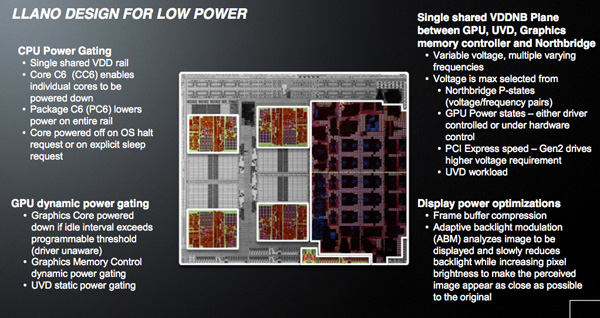
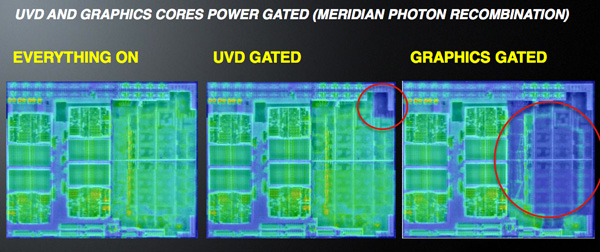
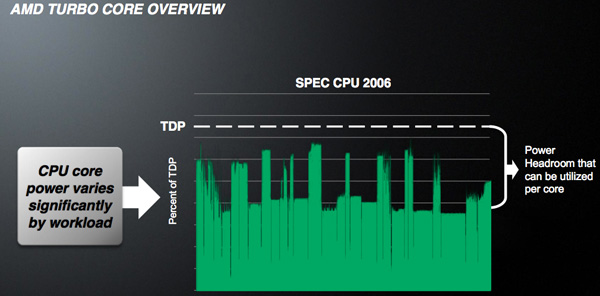
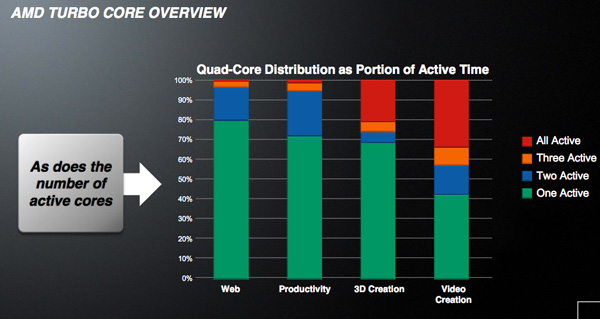
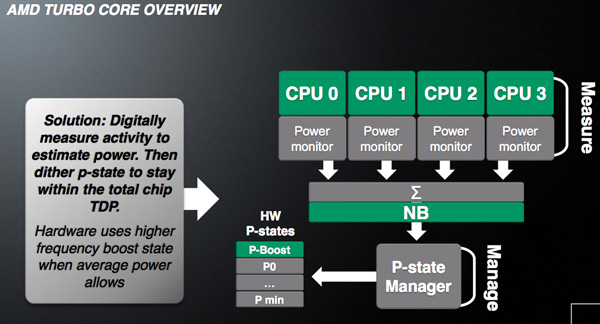
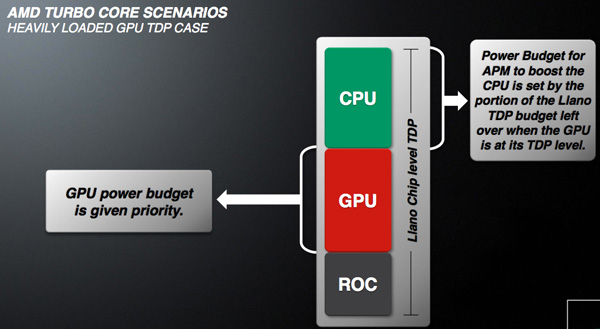
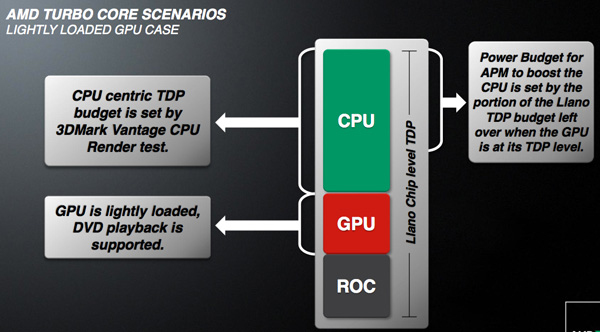








177 Comments
View All Comments
ET - Tuesday, June 14, 2011 - link
So, what do you tell them? The only benchmarks of The Sims 3 I could find are pretty old and didn't offer much detail, but I think based on them that high quality would require more than the lowest IGP. (Then again, normal or low quality should probably run fine on anything.)msroadkill612 - Tuesday, August 2, 2011 - link
ta 4 the post - but dont salesmen have a duty to sell them a bit of insurance against the next game fadash9 - Tuesday, June 14, 2011 - link
Bring on the OpenCL apps, excuse me applications- Excel rewritten to take advantage of heterogeneous computing would silence everyone about Star CPU cores. The ball is in the hands of the people (to buy them), then the software developers (to program for them) - that's why Star cores? APU apps neededmsroadkill612 - Tuesday, August 2, 2011 - link
I think it will happen. Big mobs will identify niches that can profit from OGPL & profit from using it - open languages always win in the end.I see fusion server apuS in the future.
FISHRULE - Tuesday, June 14, 2011 - link
What a terrible CPU, who would want something that performs like a Phenom in a new computer circa 2011. The future might be fusion AMD, but you sure as heck aren't part of the future anymore.jabber - Tuesday, June 14, 2011 - link
90% of laptop owners wouldnt know if they were using a Brazos or an i5 in their laptops.The only real differential is in transcoding, ripping etc. and very few folks in the real world actually do that. Especially on laptops.
Price is far more important than outright performance. Has been for some time now.
RussianSensation - Tuesday, June 14, 2011 - link
False. My gf doesn't know anything about computers. But she somehow knew that Intel makes the best mobile CPUs even before asking me what to get. Clearly Intel marketing > AMD's. All of my current friends who just bought a computer all went with i3/i5/i7 processors only because they "heard" Sandy Bridge is the fastest CPU around.Llano is nothing more than a Phenom with a faster GPU. Phenom already didn't sell well against C2D/C2Q/Core i7 (1st) gen and isn't getting any better against SB. The only way AMD is gaining market share is if they ship cheap laptops with Llano to users for whom the price of a laptop is the most important factor.
ET - Tuesday, June 14, 2011 - link
Well, you have pretty computer literate friends. Most people I know would have no idea what Sandy Bridge is, probably not even what i3 and i5 are, and would only buy i3 or i5 because: a) AMD had very little market presence until now; b) I'd recommend them. That said, most of the people I know have no idea that AMD exists and is making CPU's (I mention it occasionally, and they're always surprised, so I guess it doesn't register), so it does look like AMD's marketing is pretty crappy.That said, I think that your analysis of why Llano will fail isn't right. For most people the CPU power really doesn't matter that much. They'd have no idea if i3 or Llano is better, and most likely won't be able to tell the difference in practice (unless they run a game for which the HD 3000 is unsuited). Sure Llano is for the low end market, but that's where most sales are, and it's certainly much improved in terms of power usage, which is an important enough measure to help it gain market share.
RussianSensation - Tuesday, June 14, 2011 - link
You are probably right that most people won't tell the difference between a Llano or an i3/i5/i7. But to them the perception of knowing that they have a slower CPU is what matters. One of my friends was building a PC for browsing the net only. I told him he'd be perfectly fine with a $100 CPU but he insisted that the system must have Sandy Bridge because it's the latest modern CPU. I gave up trying to convince him that his internet browsing experience will be more limited by his ISP latency and speed rather than CPU performance.So as long as AMD convinces the average consumer that Llano is at at least as good, they will do well. The problem is AMD's marketing department is worse than a 1st year undergrad student studying marketing in business school. They think if they pay millions of dollars to put AMD on F1 cars, people will notice?
You made a very important point - a lot of people don't even know what AMD is or that there is another competitor to Intel. Imagine if GM, Ford or Chrysler made cars that were more reliable than Honda or Toyota. It would still be a while until the average consumer would abandon the Japanese brands since the perception of reliability would lag behind reality. AMD has this similar problem with their CPU brands, which only marketing can fix.
jrs77 - Tuesday, June 14, 2011 - link
Really... that's rather unimpressive.The GPU of Llano beats intels HD-graphics in games, what a surprise. But how many people do I know personally, that play games on their laptops anyways? Laptops are primarily used as mobile office-computers and they do still rely more on CPU-performance.
From all the experience I've made the HD3000 graphics of mobile SNB CPUs are perfectly fine for all tasks I throw at them (excluding games). So the question is, why would I buy a Llano-based laptop instead of a SandyBridge one?
Llano doesn't offer better battery-life so the only reason might be the price, but with i5-2xxx laptops starting at $600 I really don't see alot of competition there for intel, if we're talking anything else then gaming.